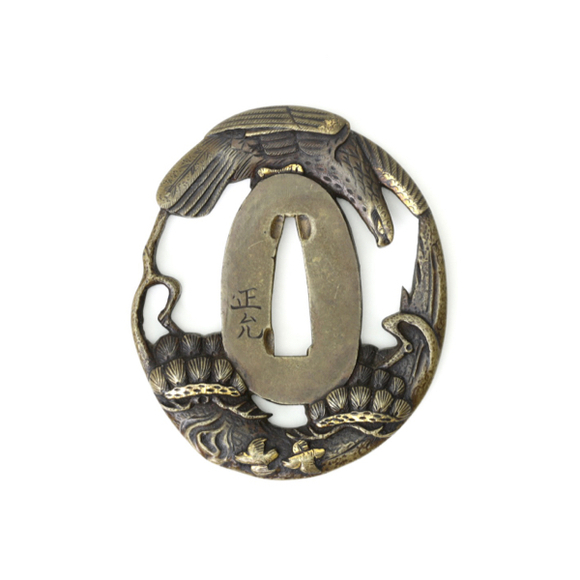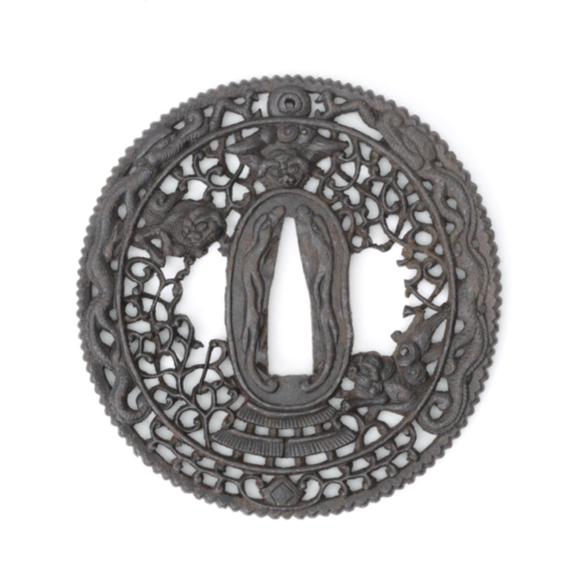Russet iron, one-piece construction with decorative grooves.

65.2 cm
Nagasa 53.4 cm
(blade length)
Sori 0.6 cm
(curvature)
Motohaba 31 mm
(width at base)
Sakihaba 21 cm
(width at kissaki)
Kissaki 31 mm
(point length)
Nakago nagasa 14.8 cm
(tang length)
Nakago sori 1 mm
(tang curvature)
Bare blade 475 grams
Bare blade 18.5 cm from base
Iron, steel, gold
Kunikiyo, Horikawa school
Yamashiro province
Test cut dated May 4, 1666
Probably made in the early 1660s
Mike Yamasaki, 2018
Historical context
Around 1600, following a long period of intense civil wars, Japan was finally united under one ruling house; the Tokugawa Shogunate. This started the Edo period (1603-1867), a long period of relative peace.
Samurai started wearing the daishō, consisting of the long katana and a short sword wakizashi, as a symbol of their class. Where in the previous period most swords were mass-produced for battle, the Shinto swords saw increased attention to detail and aesthetics in both swords and mounts. In Japanese sword collecting culture, the swords made before around 1600 are referred to as Koto (old swords) and the swords made after 1600 as Shinto (new swords.)
Pre-Edo Japan was a harsh environment of near-constant warfare. The elevated warrior class either tested their blades in battle or had the right to practice cutting or testing their swords on felons. Or, when those were in short supply, they could cut down random commoners in the streets without suffering any consequences. By the mid 17th century most samurai only knew of battles from the stories passed down in their families. Times of peace also hailed in times of contemplation, and the wanton killing became something that became frowned upon.
This gave rise to a market for professional sword testers who tested their swords on convicted felons who were up for death sentences. Yamano Ka´emon Nagahisa, the most famous sword tester in Japan in the 1600s was the first to have the results of such tests inlaid into the blade tang in gold. Such kinzogan mei included the date, his name, and personal seal (kao), which kind of cut was performed, through how many bodies. Yamano’s tests cost as much as a sword from a reputable maker at the time, he was that famous. This was the start of a long line of professional sword testers that had their test results inlaid in gold in blade tangs, lasting all the way into the 19th century.1
Notes to introduction
1. Markus Sesko; Tameshigiri, the history and development of Japanese sword testing. Self-published.
The smith; Kunikiyo
The Kunikiyo line of smiths started with Shimada Kichiemon, born in 1602 in Matsuhiro city, Shinshu. Initially a student of his father the swordsmith Shimana Sukemune, he left his hometown and became a star student of grandmaster swordsmith and samurai Horikawa Kunihiro. Kunihiro was known for making swords in many different styles, often with horimono.
He left Kyoto in 1614 after his master’s death went on to serve the Daimyou of Echizen, Matsudaira Tademasa in 1616. In 1627 he changed his name to Kunikiyo, using his master's character for Kuni (國), when he was granted the Yamashiro-daijo noble title from the imperial court. He gained the more prestigious Yamashiro-no-kami title in the following year, 1628.1 He was then also allowed to carve the 16 petal imperial family chrysanthemum mon into his swords, a very high honor. Old sources are not consisten in when he passed, either in 1649 at age 60 or 1665 at age 76.2
The title and smith's name were then continued by his son. The work of the first and second-generation Kunikiyo is nearly indistinguishable, both consistently produced high-quality blades. They worked mostly in suguha hamon which they mastered like few others, as is apparent from this sword. The second generation achieves slightly tighter forging than the first, while the first generation produced brighter crystals in the hamon.
Also the style of signatures between the two generations is nearly indistinguishable, but after a lot of research, I came to conclude it must be a very early second-generation work, probably produced between the death of the 1st generation and the performance of the cut in 1666. The second generation eventually started to write "一" (ichi) under the chrystanthemum mon but did not do this yet on his early works. It are mainly the writing styles of “shiro” in Yamashiro and "Kuni" in Kunikiyo that point towards the second generation.3
1st and 2nd generation Kunikiyo swords are rated jo-saku (上作, superior made) and wazamono for sharpness, which quite literally means “an instrument that plays as it should”, a reference to their excellent cutting ability.4
Also see my glossary article: Kunikiyo.
"In the Shinto period there were many smiths who engraved the chrysanthemum mon and sometimes added the character ichi after it. The most famous of these was Kunikiyo, a pupil of Horikawa Kunihiro who after his master's death in 1614 returned to his native province of Shinano and soon afterwards entered the service of the Matsudaira family of Echigo province." 5
-Kanzan Sato (1907-1978)
Former chairman of the N.B.T.H.K.
Notes
1.For the process of attaining these titles, see Markus Sesko; How honorary titles were conferred.
2. Markus Sesko; Swordsmiths of Japan A-Z. Lulu Inc. 2015. Page 430.
3. Various authors; Nihon To Koza (Lectures on Japanese swords). Volume 4. Translation by Harry Afu Watson. Page 84. Also see Kataoka; Nihonto Zuikan. Shinto volume. Page 701.
4. Fujishiro Matsuo; Nihon Toko Jiten. Koto Hen. Tokyo 1973.
5. Kanzan Sato; The Japanese Sword. Kodansha International and Shibundo. Tokyo, New York, London. 1983. Pages 99-102.
The sword
A 17th-century wakizashi (脇差) made by second-generation Kunikiyo. It was probably made between 1665; the passing of the first generation, and May 1666; the performance of the test.
Of a typical Kanbun era (1661-1673) shape with a strong base, moderate curve, and relatively short tip section. The blade has a somewhat open grain, a typical trait of the Horikawa school that Kunikiyo was an exponent of.
Shobu-zukuri, iori mune with steep oroshi, chu-kissaki.
(Typical Japanese sword form with ridged cross-section and peaked spine, with relatively steep slopes.)
Kitae: Ko-itame hada with areas of masame. Ji-nie, chikei.
(Forging: small wood grain hada with areas of straight grain. Larger martensite chrystals above the temper line, together with blackish rows of such chrystals.)
Hamon: chu-suguha, abundant nie.
(Temperline: medium width straight temper line with lots of martensite chrystals.)
Boshi: sugu becoming ko-maru with nie kuzure, becoming like kaen.
(Temperline at tip: straight becoming a small turn and brush-like fraying.)
Nakago: Ubu, maru kurjiri, yasurime is sujikai. One mekugi ana.
(Tang: unshortened, rounded butt. Diagonal file marks from upper left to lower right. One peg hole.)
Papers: N.B.T.H.K. Hozon. It comes in an older polish with some blemishes, see photos, but none that are in the way of appreciating the sword. It is also in an older shirasaya.
Hamon
The tight suguha hamon was achieved by covering the sword in special clay of varying thicknesses and then quenching it in water. The thickness of the clay determines how fast that part of the blade cools. Slower cooling makes a tough steel structure, where the faster cooling applied on the edge means a harder edge, where crystals are formed which appear brightly in the steel. Kunikiyo was famous for his skillful execution of the suguha hamon, his excellence shows in the remarkable consistency of the nie crystals that form a bright line of even width from base to tip.

Another notable feature is that the forging pattern is a moderately wavy masame near the edge which shows more activity right where Kunikiyo placed the hamon. The effect is seen from base to tip and was very deliberate, creating lines that move in and out of the hamon. The beauty of this sword is in the extreme subtlety of these effects which take a keen eye to notice and are hard to capture on camera.

Notice the subtle wavy effect under the glare.
Impressive once you realize it is deliberate, and it took preparation from forge-folding of the steel onwards.

Both sides of the boshi showing the nie kozure becoming kaen;
nie arranged like a stroke of a brush.
A rarer feature on Kunikiyo.
Horimono
On both sides of the blade are engravings, called horimono (彫刻). Bamboo on the left side, and edagiku (chrysanthemum branche) on the right side. Bamboo symbolizes resilience and purity. The chrysanthemum symbolizes longevity and nobility.
Horimono were sometimes added later by a separate carver, but it is believed that the first and second generation Kunikiyo did these themselves as several Kunikiyo signed blades are known with the exact same horimono.1 and one signed Kunimune (国宗), an early name used by the second generation before continuing in his father's name.2
Notes
1. See for example Kanzan Sato; Shinto oshigata dictionary. Quality Communications Inc. Tokyo. 2005. Page 66.



It comes with a fine two-piece, gold plated habaki.
Some gold lifted up on the left side. See photo.
Signatures
The nakago (tang) is inscribed on the left side with a 16 petal chrysanthemum and the smith’s mei (signature) containing his name and title. Signing on this side was normally reserved for large tachi swords that were worn edge down, but Kunikiyo signed many swords regardless of length with a tachi mei.
 |
 |
|
(May 4, 1666.) 山野加右衛門尉永久 貳ッ胴截断 |
“Lord of Yamashiro [Kyoto] province, Fujiwara Kunikiyo” |
The cutter: Yamano Ka’emon Nagahisa (1598-1667)
Nagahisa was the most notable sword tester of the 17th century. Cutting student of high-ranking samurai Nakagawa Saheita, he rose to prominence as the main sword tester of the early Edo period.
He was 16 when he first performed a cut on a human body. In the Yamano family records, we can read that he practiced diligently, 300 cuts in the morning and 800 in the evening. Between age 20 and 50 he stated he performed about 6000 test cuts on human bodies, using an average of 5-7 bodies a day, but some days up to 27. Swords tested by Nagahisa range from 1639 to 1666. He cut through one to sometimes four bodies in a single stroke.1
Notes
Markus Sesko; Tameshigiri, the history and development of Japanese sword testing. Lulu Publishing. 2014.
Importance of this sword
Produced by one of the best swordsmiths of the day, Kunikiyo, who worked for the Daimyou of Echizen and was granted high noble titles. It bears striking horimono on either side in the Horikawa style, skillfully executed. Special attention was put into the cutting edge, both its forging and its tempering, and the blade features nie kuzure in the boshi that is rarely seen with this smith.
The blade was successfully tested by the most famous sword tester of the day, Yamano Ka’eamon Nagahisa. A remarkable feature is that Yamano cut through no less than two bodies in a single stroke, at nipple height. This is a very difficult cut to perform with a sword this short. Only 1 in 7 known test cuts that Yamano did were with a wakizashi-sized blade, most of them through a single body. His last known cuts are in the 11th month of the same year, only 6 months after the cut commemorated on this sword.1 He passed away not long after at age 69.
Blades by Kunikiyo are highly sought-after, as are blades tested by Yamano.
Notes
1. Markus Sesko; Personal communication.















Unusual tsuba with foreign figures and Chinese auspicious symbols.






